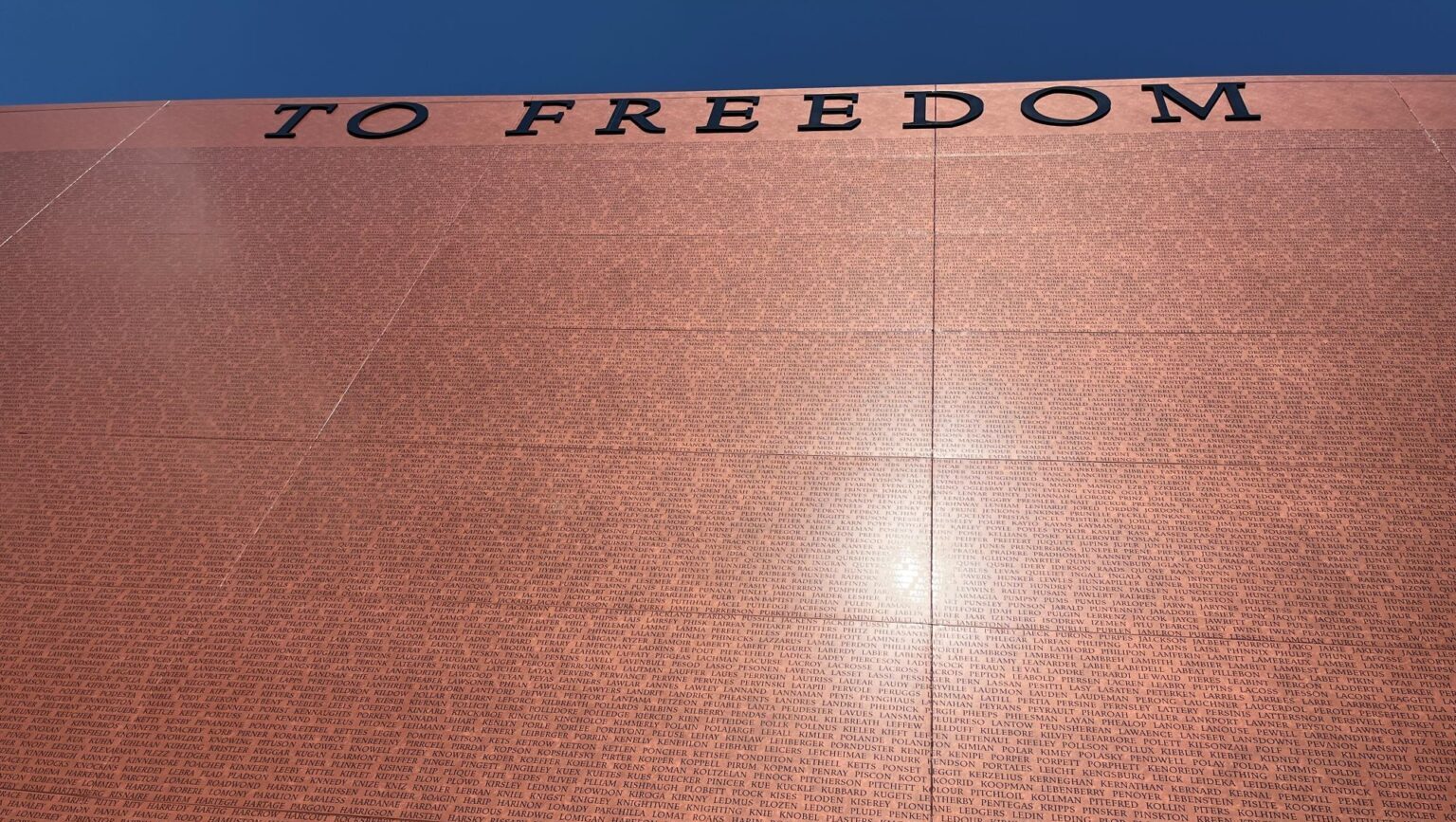
By Bryan Lyman
You can’t understand the scope of 122,000 names until you see them on a wall.
Stand at the foot of the National Monument to Freedom, recently dedicated by the Equal Justice Initiative in Montgomery, Ala., and you’ll see all of them, soaring three or four stories above your head.
Each name, taken from the 1870 census, belonged to a former enslaved person. These are surnames. Family names. Combined, they represent about 4 million people who emerged from bondage.
Each one stands for an American once treated as an animal. Someone who could be abused and assaulted under the law. Who could be stripped naked in front of a crowd of rich men; poked and prodded, and sold away from parents, spouses and children.
You get a taste of this horror in a park surrounding the monument and along a path leading to it. There are slave cabins. And a rail car that transported human beings like cattle. Surrounding all of it are statistics that measure toll of human bondage; stories that illustrate it, and carvings of the laws that upheld it.
There’s this chilling statistic from EJI: about 6 million Americans died as the property of someone else.
By the time you reach that wall, you know that each name represents not just those who survived, but dozens if not hundreds of people who lived and died as prisoners. Each one stands atop a mountain of pain and trauma, deposited like sediment over generations.
It’s led me to think about a phrase that seems inescapable when we approach federal holidays like Independence Day.
Freedom isn’t free.
I’ve heard it invoked many times over the last 23 years. The slogan is usually employed to bludgeon critics of the nation’s disastrous military actions following 9/11.
But the National Monument to Freedom gives the phrase a new meaning.
When the United States came into being on July 4, 1776, each of its 13 constituent parts allowed enslavement. Congress struck out a paragraph condemning the slave trade from an early draft of the Declaration of Independence. There was never anything condemning slavery itself.
Human bondage declined during the Revolution, particularly in South Carolina and Georgia. In Generations of Captivity, a history of slavery, historian Ira Berlin writes that the enslaved population in Georgia fell two-thirds between 1775 and 1783. It fell by a quarter in South Carolina during that period.
That was due to chaos, not ideals. In a revolution, state authority collapses. Without state authority, it’s hard to keep people subjugated. And enslaved people took advantage of the opportunity.
But war is a poor liberator. Slavery reasserted itself in both states within a decade. And there was nothing on paper that would have kept it from going on forever.
Except Americans.
Enslaved people resisted in ways large and small, defending their humanity in a system determined to rob them of it.
It was two enslaved people — Mum Bett and Quock Walker — who pushed Massachusetts courts to declare in 1781 and 1783 that the state’s new constitution had abolished slavery.
It was Black men and women, aided by white allies, who ran the Underground Railroad and put themselves on the line to get people out of slavery.
None of this was easy. Success was not guaranteed. It took centuries to end the institution. Every member of every family listed on the National Monument to Freedom knew someone – a parent, a child, a loved one – who lived and died as someone else’s property.
But by the eve of the Civil War, the work of brave men and women had broken through in the north. And created a bloc of politicians whose primary goal was putting slavery on the path to extinction, if not abolishing it outright.
That came from people on the margins of society, demanding what had been denied them: respect; the rule of law and a voice in their governance.
Freedom isn’t free. But it’s not armed conflict that pushes freedom forward. More often than not, it’s the person wounded by power at its most nihilistic who broadens the boundaries of liberty. It’s the lawyer who helps register voters in defiance of a regime working to stop it. And it’s the people who march for their rights with law enforcement against them.
These men and women push past the inertia of the ordinary to grab an ideal that seems impossible.
If we can celebrate a free society on Thursday, it’s not because of centuries-old philosophers or decades-old battles. It’s because Americans who were not free took risks and made sacrifices that lifted this nation higher than it was before.
The 122,000 names on the National Monument to Freedom testify to the enormity of that task. And remind us that the seed of justice is often planted in those who have the least of it.
Like the S.C. Daily Gazette, the Alabama Reflector is part of States Newsroom, a nonprofit news network supported by grants and a coalition of donors as a 501c(3) public charity. Alabama Reflector maintains editorial independence. Contact Editor Brian Lyman for questions at info@alabamareflector.com. Follow Alabama Reflector on Facebook and X.
Brian Lyman is the editor of Alabama Reflector. He has covered Alabama politics since 2006, and worked at the Montgomery Advertiser, the Press-Register and The Anniston Star. A 2024 Pulitzer finalist for Commentary, his work has also won awards from the Associated Press Managing Editors, the Alabama Press Association and Robert F. Kennedy Center for Human Rights. He lives in Auburn with his wife, Julie, and their three children. Alabama Reflector is part of States Newsroom, the nation’s largest state-focused nonprofit news organization.








